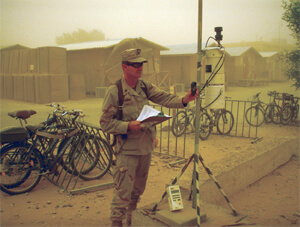Research
With support from the Department of Defense, National Jewish Health is searching for the causes and mechanisms of deployment-related lung diseases that impact our military personnel and veterans.
Our research program is designed to:
Find noninvasive tests for diagnosing deployment-related lung injury
Explore interactions between smoking, allergens, viruses and deployment dust
Understand individual risk factors for these lung conditions
Investigate cellular and molecular mechanisms of lung injury
Develop targeted treatments based on scientific evidence

Iraq veteran Dr. Richard Meehan testing air quality in a dust storm in the Middle East.
Clinical Research
Our center has several ongoing studies including a research database and biorepository as well as the Group on Lung Injury from Deployment (GLIDE) Study. Without the participation of active duty military men and women and veterans seen in our center, we could not do this important work.
If you are interested in participating in our studies, please submit a clinical trial interest form. Our team will reach out to you to discuss potential research opportunities.
Please be sure to continue to visit our website to stay up to date on upcoming research projects and to be informed about results of this work.
Below are some of the published research studies that could not have been done without participation from military personnel and contractors who have deployed since 9/11/2001.
Military Occupational Specialty Codes: Utility in Predicting Inhalation Exposures in Post-9/11 Deployers. Journal of Occupational and Environmental Medicine. 2019; 61:1036-1040.
Military occupational specialty codes (MOS) can help identify high-risk military occupations where medical surveillance and exposure control should be focused. Those in combat positions are more likely to be exposed to inhalational hazards tied to specific job duties while deployed. MOS codes can also help inform the frequency and intensity of exposure to diesel exhaust, sandstorms, burn pits, combat dust, and other occupational vapors, dusts, gases, and fumes.
Respiratory Diseases in Post-9/11 Military Personnel Following Southwest Asia Deployment. Journal of Occupational and Environmental Medicine. 2020; 62:337-343.
Persistent respiratory symptoms following 9/11/2001 military deployment to Iraq and Afghanistan are common. Among patients seen at National Jewish Health’s Center for Deployment-Related Lung Disease, deployment-related distal lung disease, asthma, rhinitis, sinusitis, and intermittent laryngeal dysfunction/vocal cord dysfunction were frequently diagnosed. A comprehensive diagnostic approach may help identify a spectrum of respiratory diseases that requires a personalized approach to care.
Multiple Breath Washout: A Noninvasive Tool for Identifying Lung Disease in Symptomatic Military Deployers. Journal of Respiratory Medicine. 2021; 176:106281.
Multiple breath washout (MWB), a non-invasive breathing test used to detect large and small airways injury, was evaluated as a tool for detecting deployment-related lung disease in symptomatic military personnel. Deployers had significantly higher measures of ventilation inhomogeneity (non-uniform gas exchange in the lungs) compared to healthy controls. Patients with both distal disease and asthma had the most abnormal scores. Additionally, deployers who reported frequent exposure to explosive blasts during deployment had more abnormal scores.
Semi-Quantitative Chest CT Assessment Identifies Expiratory Central Airway Collapse in Symptomatic Military Personnel Deployed to Iraq and Afghanistan. Journal of Thoracic Imaging. 2021. In press.
A common airway finding in symptomatic military personnel returning from deployment is expiratory central airway collapse (ECAC). ECAC can be diagnosed on chest CT imaging with dynamic expiration. Among 62 deployers with persistent dyspnea (shortness of breath) that were evaluated in our clinic, 37% had ECAC. Three had severe (>85%) collapse. A standardized approach to CT-based assessment of ECAC should improve reliable diagnosis in patients with respiratory symptoms.
Particle Morphology and Elemental Analysis of Lung Tissue from Post-9/11 Military Personnel with Biopsy-Proven Lung Disease. International Journal of Environmental Research and Public Health. 2023; 21(1):91.
There is a clear connection between some lung diseases occurring in previously deployed veterans and their military exposure to particulate matter (PM). In collaboration with scientists at the United States Geological Survey (USGS), National Jewish Health researchers examined the content of different elements -- silica, titanium, lead and other metals -- in lung tissue samples from veterans who have deployed since 2001. Compared to healthy control lung samples, veterans’ lung tissues had significantly higher levels of silica and silicate particles. This was particularly notable in those who served in combat environments. Study findings underscore the importance of minimizing dust exposures during deployment to protect the respiratory health of those in military service.
If you are interested in supporting our work financially, please consider donating to the Sergeant Sullivan Fund.
Basic Science
This research is in collaboration with other investigators at National Jewish Health. Learn more about our collaborating labs below.
